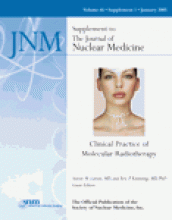Abstract
Peptide receptor scintigraphy in combination with anatomic imaging methods such as CT can be regarded as molecular imaging. It offers insight into the variability of somatostatin receptor expression in neuroendocrine tumor lesions within a patient. The somatostatin receptor status of all tumors in a patient is an important issue, because receptor-negative lesions may be poorly differentiated and characterized by aggressive growth and poor prognosis, with consequences for the choice of therapy. Methods: Follow-up studies of 3 patients with gastroenteropancreatic neuroendocrine tumors who had been previously treated with peptide receptor radionuclide therapy (PRRT) are presented. Results: Patient 1 had a mixed response after treatment with 90Y-1,4,7,10-tetraazacyclododecane-N,N′,N″,N‴-tetraacetic acid0 (DOTA),Tyr3-octreotide. The response included fibrosis and a low rate of mitosis in receptor-positive lesions that had decreased in volume after treatment and vital tumor cells and a high rate of mitosis in receptor-negative lesions that had grown since the start of treatment. Patient 2 had a good clinical and biochemical response after PRRT with [177Lu-DOTA0,Tyr3]octreotate (177Lu-DOTATATE), with disappearance of 111In-pentetreotide uptake on follow-up scans, whereas on CT the size of the lesions remained unchanged, possibly indicating tumor necrosis. Patient 3 had a complete remission after PRRT with 177Lu-DOTATATE but subsequently relapsed with many receptor-negative metastases, requiring intensive chemotherapy. Conclusion: Although biopsy is required for initial diagnosis and treatment planning, noninvasive molecular imaging may evolve into in vivo molecular pathology in selected groups of patients, especially in treatment follow-up.
Footnotes
Received Sep. 15, 2004; revision accepted Sep. 17, 2004.
For correspondence or reprints contact: Eric P. Krenning, MD, PhD, Department of Nuclear Medicine, Erasmus Medical Center, Dr. Molewaterplein 40, 3015 GD Rotterdam, The Netherlands.
E-mail: E.P.Krenning{at}erasmusmc.nl







